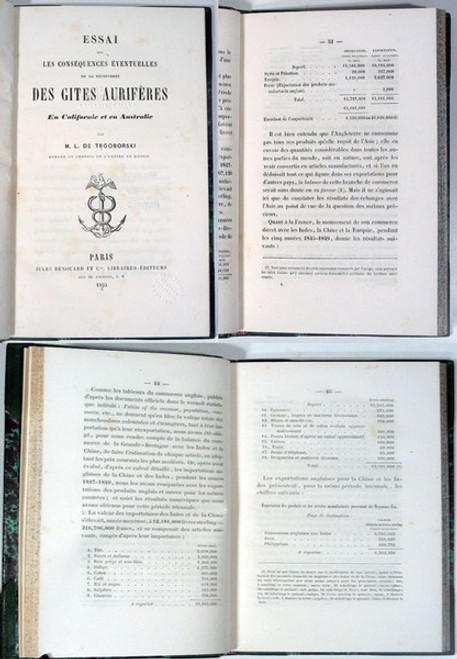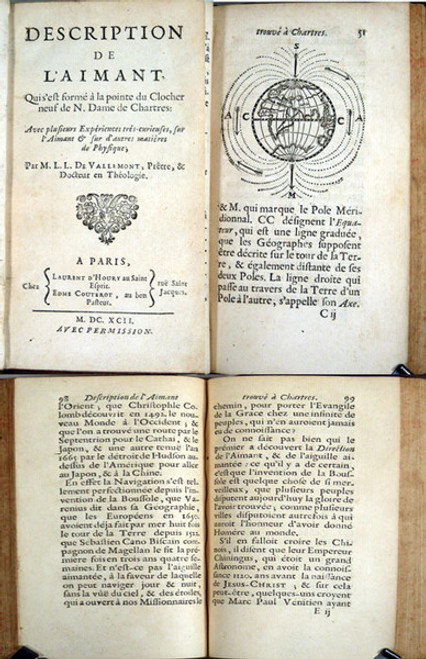D’Aubuisson De Voisins, Jean-Francois; Des Mines de Freiberg en Saxe et leur Exploitation. Three volumes complete. First edition, Pierre Phil. Wolf, Leipsic: 1802. Octavo, tome 1, pp. xxxvi, 2, 347, viii, 3 folded plates. Tome 2, pp. 2, 250, vi, 2, plates 4 - 5 , (being 2 folded maps). Tome 3, pp. 2, 286, vi, plates 6 - 8. (folded)
The set is complete with all plates and maps present as issued. Bound in contemporary boards with gilt spine titles. Light shelf rubbing to bindings, light wear to outer binding edges. The bindings remain tight, text and all plates and maps are clean and bright. In very good condition. Rare as a complete set.
Jean-Francois D”Aubuisson De Voisins, (1769-1841) was a French geologist, mineralogist and mining engineer. After serving as a artillery officer in the French army for six years from 1791 to 1797 he settled in Freiberg where he taught mathematics and also attended the Bergakademie and studied mineralogy, geology and mining under Abraham Gottlieb Werner for four years. He was to translate Werner’s first works into French. His studies also included a number of field excursions to the various Saxon mines. D’Daubuisson kept detailed notes and maps of all of the mining areas he visited. He became intrigued by the surrounding geology and basalts, especially the origins of the basalts. D’Aubuisson initially followed Werner in his geological beliefs, and he published a small book in 1803, “The Basalts de la Saxony” and proposed the sedimentary origin of basalt. Upon returning to France d’Aubusson spent far more time studying the basalts in the Auvergne region with Guettard and Desmerest who regarded the basalts as the product of volcanic eruptions He returned from these studies convinced that basalts were of volcanic origin. In 1807 d’Aubuisson became mining engineer for the departments of Doire and Sesia, in the Piedmont, now part of Italy. He was appointed chief of the mineralogical district of Toulouse in 1811 and remained there for more than thirty years in an administrative post covering the entire Pyrenees region.
It was d’Aubuisson’s original studies under Werner and especially his meticulous studies of the mines of Freiberg and Saxony that attracted him to basalts and their origins. The short book or essay “The Basalts de la Saxony” which he had published in 1803 contained many of his observations from those field trips. This essay, in which the Wernerian doctrines were adopted, was read by Haüy and Ramond, who advised d’Aubuisson to inspect the basalts of Auvergne. This d'Aubuisson immediately did, with the result that in a paper “Sur les Volcans et les Basaltes de l'Auvergne”, read to the French Institute in 1804, he abandoned many of the views on basalts he had previously held. “The facts which I saw”, he wrote, “spoke too plainly to be mistaken; the truth revealed itself too clearly before my eyes, so that I must either have absolutely refused the testimony of my senses in not seeing the truth, or that of my conscience in not straightway making it known.”
D’Aubuisson’s original observations on the mines and his interest in basalts in Freiberg and Saxony are found in his 1802 three volume set “Des Mines de Freiberg en Saxe et leur Exploitation”. The work is the first to describe the methods of mining at Freiberg. The mines are famous for their silver and lead deposits. Volume 1 covers the techniques used at Freiberg, the construction of shafts, instruments used to survey the ore deposits, methods to loosen the ore etc. In volume 2, d’Aubuisson discusses the geology of the area, the origin of the ore deposits, the history of mining in the region and the origin of the famous Freiberg Academy. In volume 3 he describes in detail each mine in the region.




















